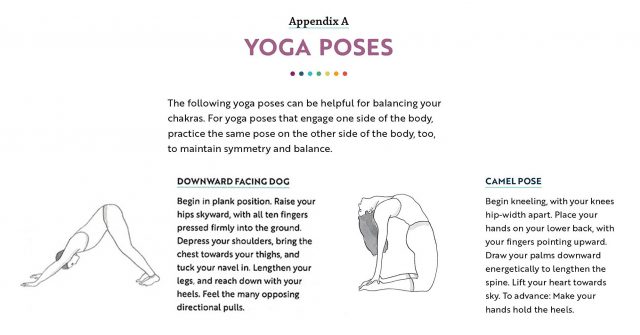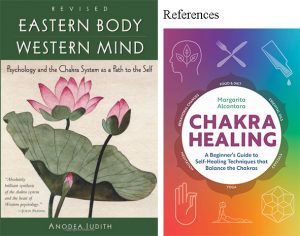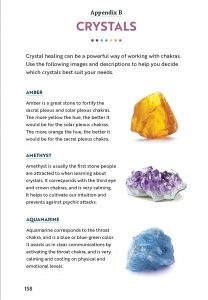Chakra for Beginners
If you believe that the physical body is affected by the mind, and vice versa, then you could surmise that one might be able to change, perhaps improve both with an application of self-determination.
The concept of chakras arose from ancient Indian Hinduism. The belief held that human life simultaneously exists in two parallel dimensions, one “physical body” (sthula sarira) and the other a “psychological, emotional, mind, non-physical” called the “subtle body” (sukshma sarira). The subtle body is energy, while the physical body is mass. The psychic (mind plane) corresponds to and interacts with the body plane, and the belief holds that the body and the mind mutually affect each other. The subtle body consists of nadi (energy channels) connected by nodes of psychic energy called chakra. (Wikipedia, amended)
There are seven chakras, with theoretical locations on your centerline, starting at the base of your spine with number 1, Root (survival), then moving upward through number 4, Love at the heart level and number 7, Cognition (spirituality) at the top of your head. See diagram for all seven.

“While they can’t be seen or held as material entities, the chakras are evident in the shape of our physical bodies, the patterns manifested in our lives, and the way we think, feel and handle situations that life presents us.” (Anodea Judith.)*
BALANCE. The chakra physiological premise holds that one may become more – perfect, happy, well-adjusted, forgiving, genuine, confident (fill in the blank) – with an application of ancient Eastern wisdom. Study a bit and you may find symptoms of your regretful actions listed under a specific chakra.
For example, certain situations may have raised your ire, causing an enigmatic explosion of nasty verbiage. If this has occurred in the presence of other humans, you will likely be ashamed of your unruly behavior. Perhaps this has happened not infrequently. Could an application of chakra know-how help you understand and calm the savage beast within? Thereby reducing future embarrassment?
CHARACTER ARMOR. This self-defense mechanism is a coping strategy for our deficient life experiences. We may have been raised by less than perfect parents. Perhaps we were bullied or ignored. Many of us are in a permanent holding pattern, mistakenly believing ourselves to be a finished product. “It’s just who I am, I can’t help it!” Our physical appearance, posture and stance will be affected by our traumas, even minor ones. Chakra gives us a “path to the Self.”
The chakra system: Identify your body armor, find your character structure, diagnose your blockage (deficiency), and perform the healing tasks (breathing, meditation, exercise techniques). How long will it take to show results? That’s up to your dedication and the depth of your trauma. For me, it has been shockingly immediate. People describe me as “Such a nice man. And so handsome!”
Let me describe how an old friend applied this system (me helping). Dave has recently retired from the space-tech industry to a small Colorado city. He’s from the country, enjoys hiking, biking, skiing, camping and all things outdoors. He owns a motorcycle, and we have ridden together many times. He travels throughout the US. He’s a bit of a loner and readily admits his personality is a little “rough around the edges.” Dave has exploded on me a couple of times, once for back-seat driving, once on the golf course when he sliced his tee shot into a water hazard and blamed me (an innocent sneeze). Upon the second occurrence, after a cold look from me, followed by an apology from him, I pulled a dog-eared copy of Eastern Body, Western Mind* from my bag.
“Let’s look at this back in the clubhouse,” I suggested.
We glanced through the introduction and easily picked out (from a graphic on p 23) his body armor: a Rigid-Achiever Character. The brief description (chart pp 24-25) of corresponding personality traits seemed to match up with the chart, Dave agrees. A few of these would be:
- Parent: sexually rejecting, cold.
- Age of deprivation: 3-1/2 to 5 years.
- Positive traits: good achiever, highly functional.
- Current personality: aggressive, proud, competitive.
- He readily admits being asked by his mom to “grow up” at age five.
- The last category is “Chakras most affected.” The Rigid-Achiever has a deficient 4th (Love).

From this chart and description, we now know the likely cause of Dave’s imperfect social skills were injected at an early age. He has carried a feeling of doubt about exercising his own rights for 60+ years. His right to want, his right to feel. He has the illusion that performance is everything. He has a fear of surrendering to feelings. Our Eastern Body reference continues the bad news. It succinctly describes the Rigid Character as a “Hurried Child.”
Looking for solutions, we turn to page 221, the chakra 4 chapter, “Finding the Balance in Love.” Sixty pages of analysis, culminating with healing recommendations, including specific exercises. In this case, deep breathing while using arms and hands to push out the bad, take in the good. A short primer on meditation, which is generally acknowledged to be helpful for the appreciation of life itself.
Chakra Healing** (in appendix A) illustrates various recommended yoga exercises, one of which was so difficult to achieve that it provoked a new spate of rage. In the club exercise room, Dave and I studied the Downward Dog diagram. Dave handled this position well in his trendy golfing garb. Next, the Camel Pose. His back stretched and bent radically, the red-faced yoga novice opened his mouth, poised to yell a string of well-rehearsed obscenities. Instead, what came out was an unexpected stammer: “Dad gum heck, my body can’t do this.”

He dropped to the mat, a confused smile on his face. “It’s working already, Bill,” he said.
Balance. Serenity. Compassion. Love.
Skeptical? I certainly was. Could this “Eastern” method of “Healing” be the answer to all MY problems? Trauma that was hidden inside for so many years, are you sure that even has anything to do with MY lack of confidence, MY wandering soul?
Take a chance. The worst that will happen is you receive some free awareness. A clue to what might be ailing you. If so, you could be more cognizant of your shortcomings, admit you are not perfect, and start to change yourself from within. Nothing ventured, nothing gained. Personally, I have expelled years of malevolence using the breathing “push out the bad” guidance.
“All living things – humans, animals, plants, trees, even the earth – have a chakra system, a living system of energy vortexes, that exists within them. When we get in touch with the energy within our chakras, we connect with ourselves more fully, and learn how to heal ourselves on all levels, creating holistic healing. This is why mindfulness-based practices, such as meditation, help connect the body with mind and spirit, why certain physical activities can help clear your head and feel more centered, and why cultivating your spirit heals your mind and body.” (Margarita Alcantara.)**
References:
*Eastern Body, Western Mind, Anodea Judith, copyright 1996, 2004, Celstial Arts. This is a 490-page textbook with a stupendous amount of detail. Helpful charts and trauma descriptions, assisting the chakra neophyte in self-discovery. My two-page dissertation above is surface level edification for amateurs.
**Chakra Healing, Margarita Alcantara, copyright 2017, Althea Press. Subtitle: “A Beginner’s Guide to Self-Healing Techniques that Balance the Chakras.” Helpful with diagrams and graphics. The crystal illustrations are an example of one more healing method. This is a small book with middle-school level info. Slightly confusing about how one diagnoses oneself. But handy; you can take it to the gym.


The End
